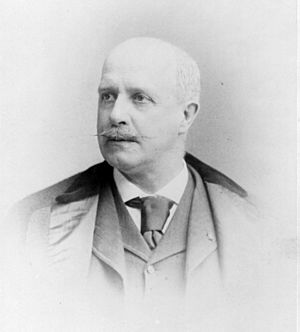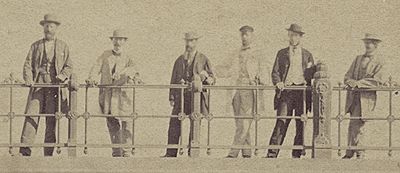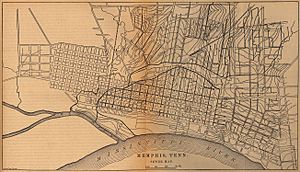George E. Waring Jr. facts for kids
Quick facts for kids
George E. Waring Jr.
|
|
|---|---|

in 1883
|
|
| Born | July 4, 1833 Pound Ridge, New York, U.S.
|
| Died | October 29, 1898 (aged 65) New York City, U.S.
|
| Monuments | Woodland Cemetery, Stamford Connecticut [Cenotaph memorial] |
| Nationality | American |
| Occupation | Sanitary engineer, civic reformer |
| Years active | 1865–1898 |
| Known for | Advocate of sewer systems that keep domestic sewage separate from storm runoff |
George E. Waring Jr. (born July 4, 1833 – died October 29, 1898) was an American engineer who focused on making cities cleaner and healthier. He was a pioneer in designing sewer systems that kept dirty household water separate from rainwater. This was a new and important idea at the time.
Contents
Early Life and Education
George E. Waring Jr. was born in Pound Ridge, New York. His father, George E. Waring Sr., was a successful stove maker. George Jr. studied agricultural chemistry, which is about how science can help farming. He even gave talks about farming science. In 1855, he started managing a farm in Chappaqua, New York, owned by Horace Greeley, a famous newspaper editor.
Career Highlights
Draining Central Park

In 1857, George Waring Jr. got a big job helping to build New York City's Central Park. He was the agricultural and drainage engineer. This was one of the biggest drainage projects ever attempted back then. Before the park was built, much of the land was a wetland, which means it was very marshy and wet.
Waring designed and oversaw the building of the drainage system. This system helped create the beautiful lakes and ponds you see in Central Park today. He loved horses and would often ride his horse, Vixen, using the park's construction areas as fun jumping obstacles!
Civil War Service
When the American Civil War began, Waring left the Central Park project to join the army. He became a major. He trained in Washington D.C. and even met President Lincoln. On July 4, 1862, he fought in the Battle of Blackburn's Ford.
Later, he joined General John C. Frémont and commanded a cavalry unit. Sadly, his horse Vixen died during a campaign in Missouri in November 1862. He then got a new horse named Ruby, who was a surprisingly good jumper despite looking a bit sad.
Waring helped create six cavalry companies for the Union army in Missouri. These units eventually formed the 4th Missouri Volunteer Cavalry. Waring was promoted to Colonel in January 1862 and led this regiment throughout the war, mostly in the Southwest.
Ogden Farm and Sanitary Innovations
After the Civil War, Waring moved to Newport, Rhode Island, in 1867 to manage a farm called Ogden Farm. This farm was a "model" farm, meaning it used the newest farming methods and technology.
At Ogden Farm, Waring brought Jersey cattle to the United States and started the American Jersey Cattle Club. He also laid special clay pipes to improve the farm's drainage, and some of these pipes are still there today! From 1877, drainage and sanitary engineering became his main focus.
He also became interested in new toilet designs. In 1881, another important sanitary engineer, William Paul Gerhard, became Waring's main helper.
Memphis Sewer System
The city of Memphis, Tennessee, had a very serious problem with diseases like cholera epidemics and yellow fever. Over 5,000 people died in 1878 alone. The city's sanitation was terrible. Many wells were too close to outdoor toilets, and the ground was often waterlogged.
Memphis leaders knew they needed a better sewer system. However, the city was very poor, especially after many people left due to fear of yellow fever. The country felt sympathy for Memphis, and this led to the creation of the National Board of Health. This board sent Waring to Memphis.
Waring designed a sewer system that Memphis could afford. His big idea was to separate sewage (dirty household water) from storm water (rainwater). This meant the pipes could be smaller and cheaper. This idea had not been used on a large scale in the United States before. Memphis built the separated sewer system exactly as Waring planned, and the terrible epidemics in the city finally stopped.
Cleaning Up New York City
In 1895, George Waring Jr. was called to New York City because the city's sanitation was a huge mess. Horses left millions of pounds of manure on the streets every day. Dead horses rotted in the streets. Garbage piles were often a foot or two deep, and cleaning was very disorganized.
Waring quickly got to work. He made a rule that horses and carts had to be kept in stables overnight, not left on the streets. He created a new Street Cleaning Department. This was a special team of workers who wore white uniforms and pith helmets. They pushed wheeled carts and were responsible for cleaning the city streets.
Waring's team cleared away huge amounts of waste. Dead horses were removed and sold for glue. Horse manure was sold as fertilizer. Other trash was sent to dumps along the waterfront. Waring's crew even cleared snow, loading it into trucks and dumping it into the rivers.
Waring's efforts were a huge success, and New Yorkers were very grateful. A parade was even held for the sanitation workers in 1896!
Work in Cuba
Because of his great reputation in sanitary engineering, President William McKinley asked Waring to study the sanitation situation in Cuba in 1898, after the Spanish–American War. Waring had actually designed a sewer system for Santiago, Cuba, back in 1887.
Personal Life and Legacy
George Waring Jr. was married three times. His last marriage was in July 1898 to Louise Yates.
Soon after his third marriage, while he was in Cuba, Waring caught yellow fever. He died shortly after returning to New York City on October 29, 1898. His body was cremated.
Today, an avenue in the North Bronx, New York, is named Waring Avenue in his honor. Memphis also has a street named Waring Road.
Waring's Publications
- Jersey cattle, being an essay on this breed. Judd, New York, 1872.
- Wedding at Ogden Farm, in Scribners Monthly Illustrated Magazine. May 1876 – October 1876, Scribner and Company, New York, 1876.
- The Handy-Book of Husbandry: A Guide for Farmers, Young and Old. in Scribners Monthly Illustrated Magazine. E.B. Treat & Co., New York.
- Waring's Book of the Farm; Being a Revised Edition of the Handy-Book of Husbandry. A Guide for Farmers. Porter & Coates, Philadelphia, 1877.
- A Farmer’s Vacation, in Reprinted (with additions) from Scribner’s Monthly Illustrated Magazine. James R. Osgood & Company, Boston, MA. 1876.
- The Sanitary Condition of City and Country Dwelling Houses. - Sanitation, Household - 1877 - 145 pages.
- Draining for Profit and Draining for Health.
- Whip and Spur.- Boston, Ticknor and Company - 1892 - 245 pages.
- Modern Methods of Sewage Disposal. D. Van Nostrand Co., NY. 1894.
- How to drain a house, practical information for householders. D. Van Nostrand Company, New York.
- Street-cleaning and the Disposal of a City's Wastes. Doubleday and McClure Co., NY 1897, 230 pp.


